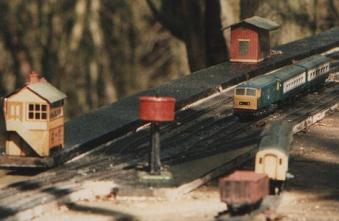BMRC - O Gauge Lines
Track
The club's O Gauge lines were constructed in the 1960's. At this time the club's stock was tinplate
and locos were powered by clockwork. For this reason the stations were placed close enough together
to allow a clockwork train to run from one station to the next.
The route was laid out as double track with loops at most stations except the junction stations where
the tracks diverged at the facing end of the station. At this time track was constructed from wooden
battens and "Bonds" track components. These consisted of cast white metal chairs supporting brass rail. All the
track was hand built. This must have been a time consuming, but rewarding, experience.
The battens were made up of 3/8" approx square wooden strip. Since most of the route is double track it made
sense to make the battens wide enough support two tracks. The wood was creosoted before assembley to extend its life.
The rails were pinned down to the battens using the cast whitemetal chairs and small panel pins. Pointwork
was constructed in a similar fashion, except that some soldering was needed.
The battens were fixed to a concrete base which in turn sat on a brick wall. The battens were screwed to pieces of that
had been embedded in the concrete base. The trackwork was very much coarse scale to suit the tinplate stock used at the
time.
Unfortunately during the 1970's the track suffered periodic vandalism when the site was broken into.
Often there was insufficient time to make repairs before the next Open Day,
when it was necessary to have the layout operating.
In order to get things running again, the decision was taken to use PECO Flexitrack instead of the Bond's track components.
As before, battens were used to support the PECO track. The replacement of the Bond's track occurred as a gradual process
through the late 1970's and 1980's. The last section to be replaced was the section between Minford and Stockton (its location
in cutting may have meant it was harder to vandalise). PECO and Marcway points were also used.
The use of PECO track had an effect on the type of stock used. Some of the tinplate stock used had wheel
flanges which were too deep to run on the PECO track.

|
This picture shows a Lima 4F on PECO track supported by wooden battens.
In some cases the voids under the track were filled with pea-gravel to simulate ballast.
This method of laying track has some deficiencies in that the wooden battens were not stable
enough to keep the relatively weak PECO track in place.
|
During the 80's the club aquired some long, painted planks of wood which had been recovered from an
old fence. These were tried out and proved to be better than the wooden battens.
However, after a few years the planks rotted and had to be replaced.

|
Newton Station in the mid 1980's. The track is laid on the old fence planks referred to above.
The line in the foreground is the branch line from Newton to Nine Elms.
The buildings and water tower are tinplate and have been set out for an Open Day.
|
The current method of track construction uses wood or plastic planks. The planks are wrapped in
roofing felt in order to protect them from the elements. Using this method the track has a life in
excess of ten years. For station areas sheets of plywood are cut to the required size; these are also
covered in roofing felt.
The wooden planks are still mounted on a concrete base. In some areas the original brick walls
which supported this base have deteriorated due to frost damage and ground-heave. These walls have
been replaced with new walls constructed from concrete blocks.
The pointwork uses a mixture of PECO, Marcway and scratch built pointwork. Most points are
fitted with an over-centre spring to hold them locked in place.
Recently we have developed a point which accommodates both fine and coarse scale wheels.
Our intention to covert all points to this type over the next few years.
Pointwork construction is simplified
due to the fact that the rails are not electrified and therefore the point frogs and tie-bars do not
have to be insulated.

